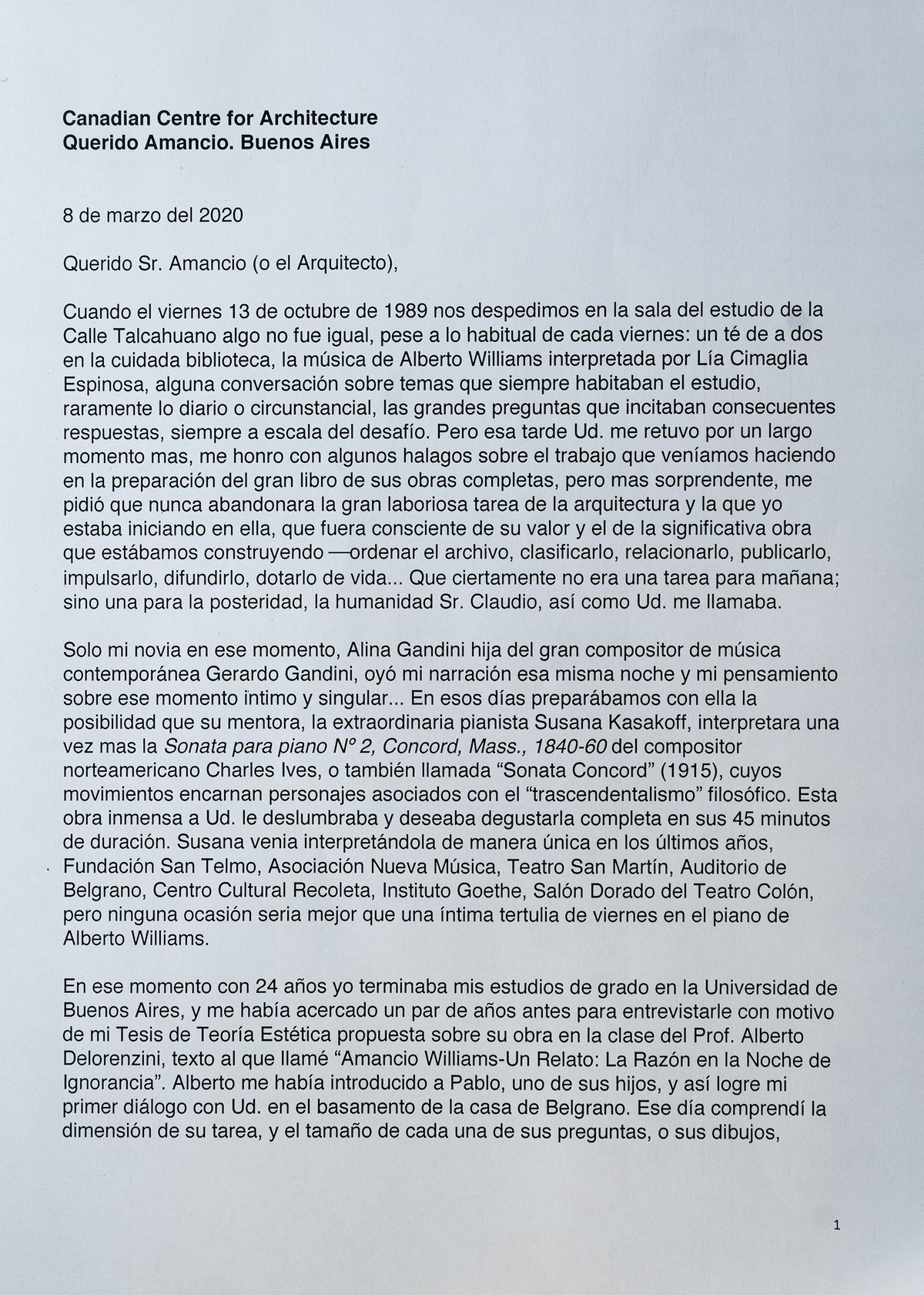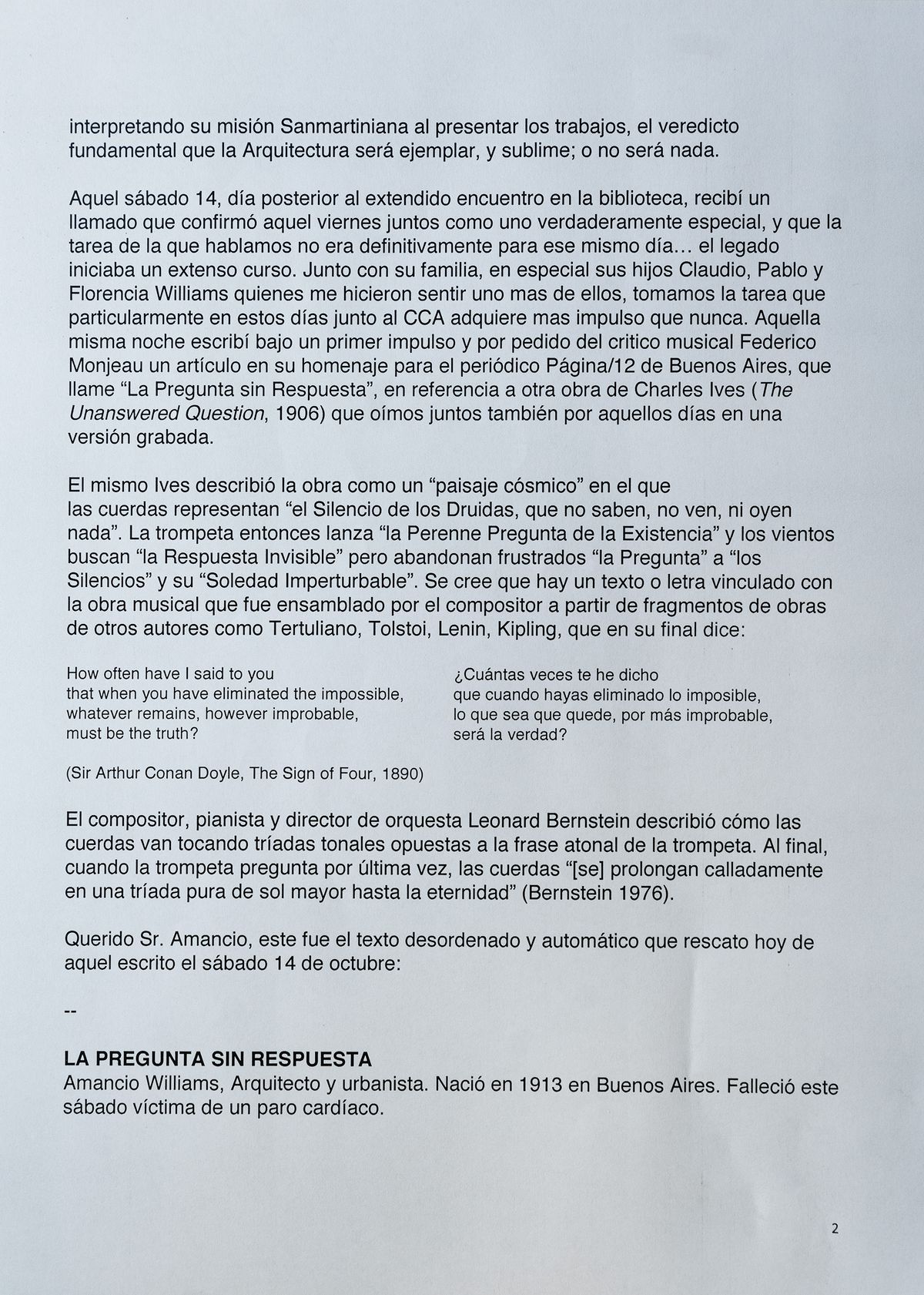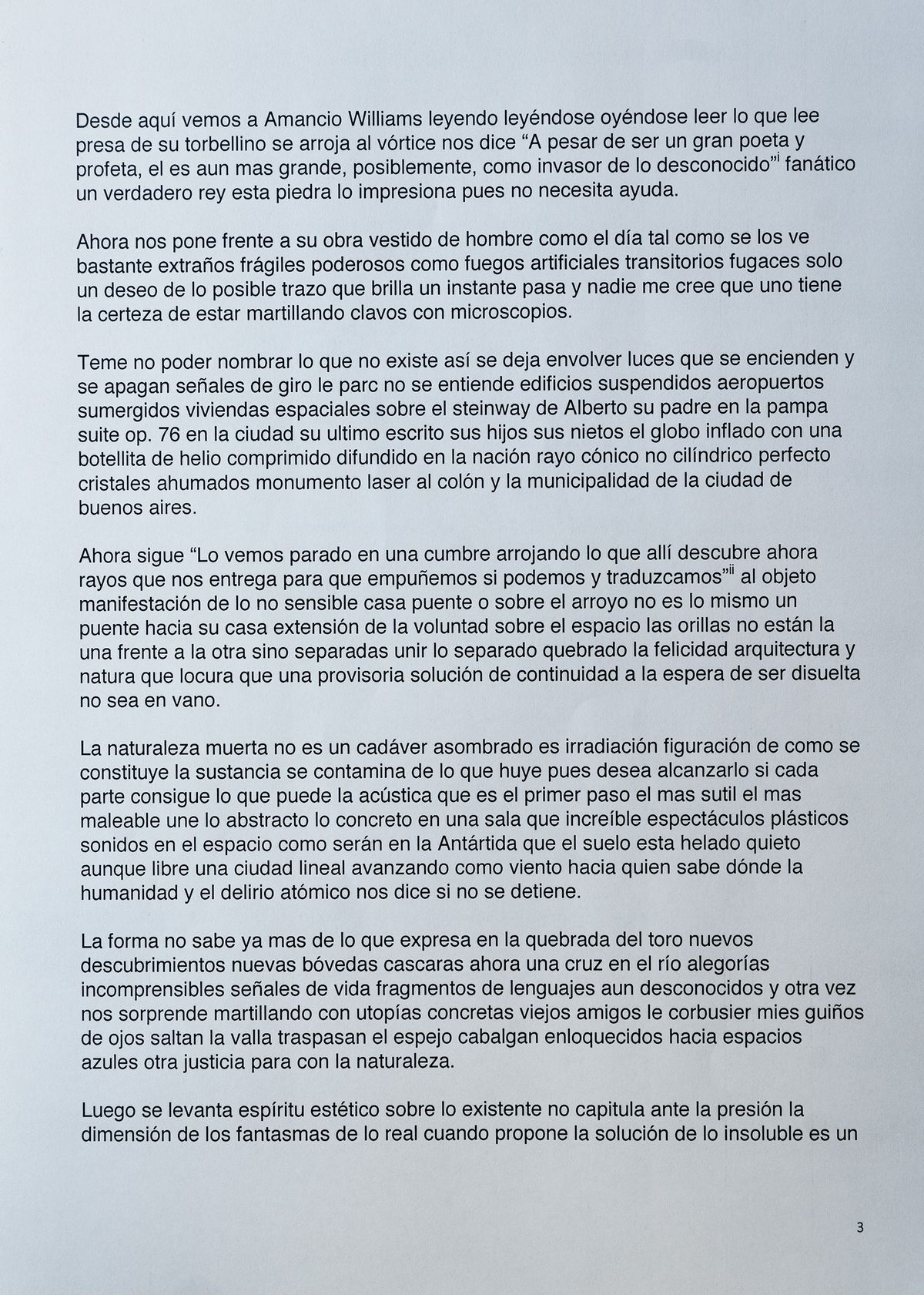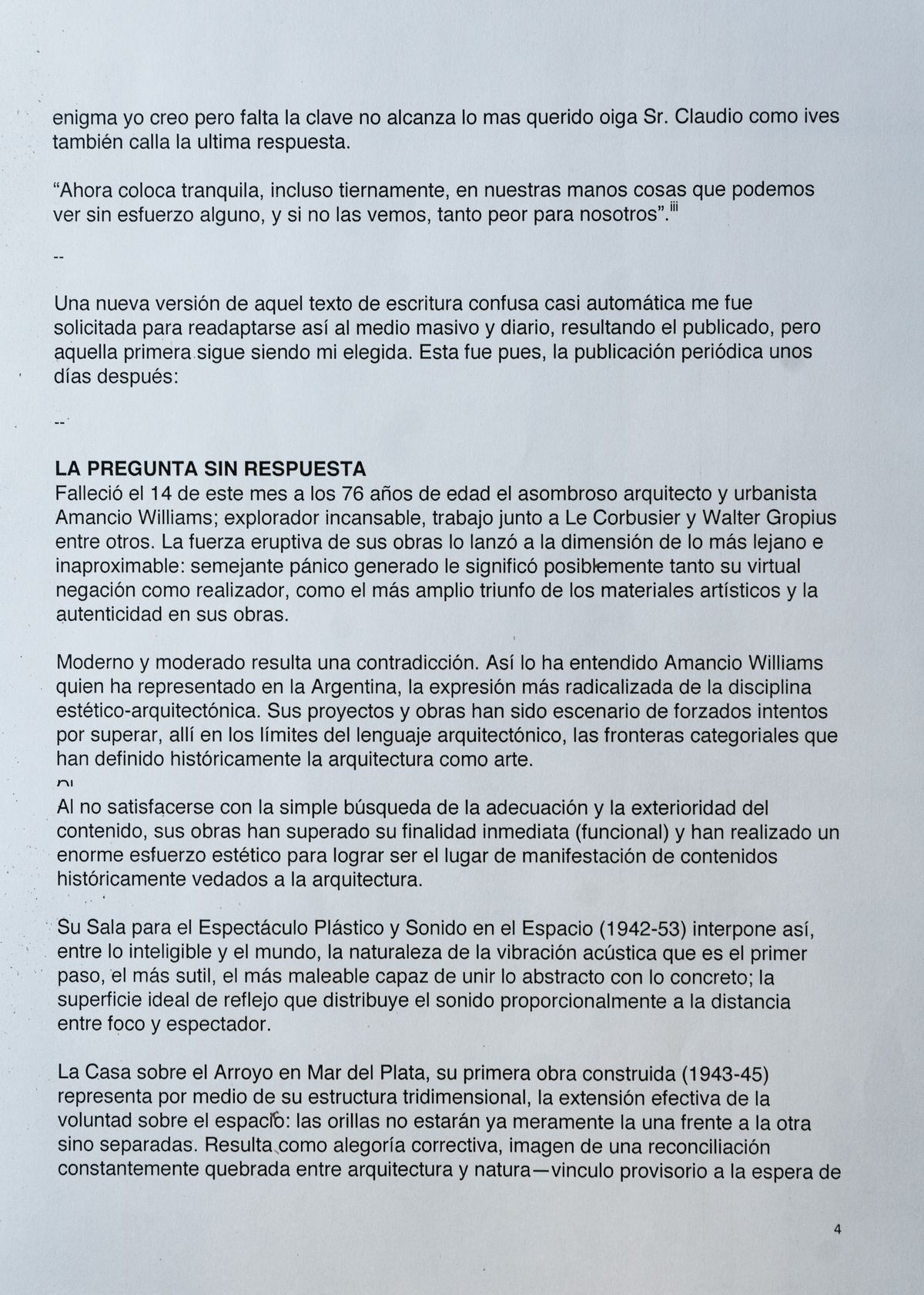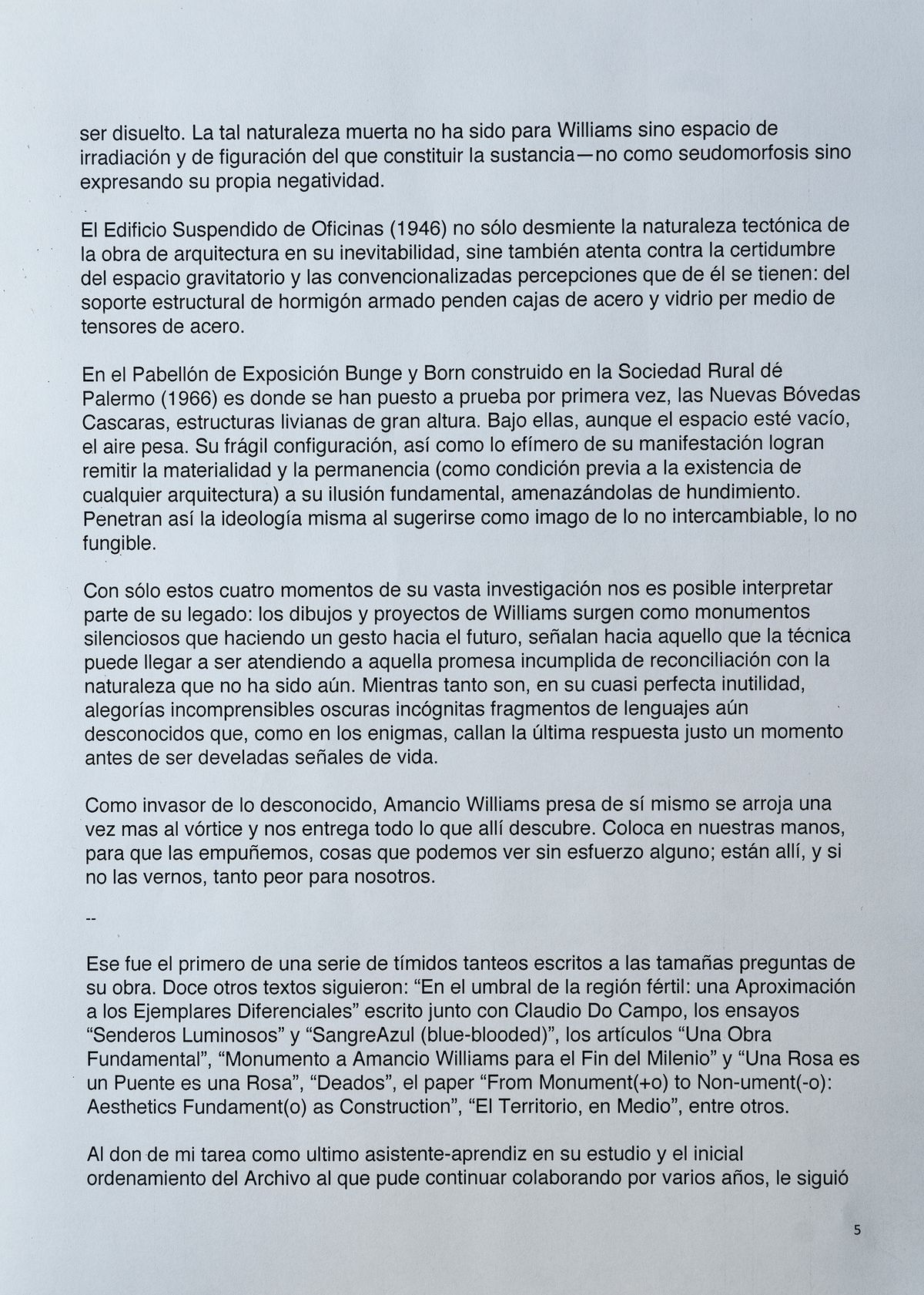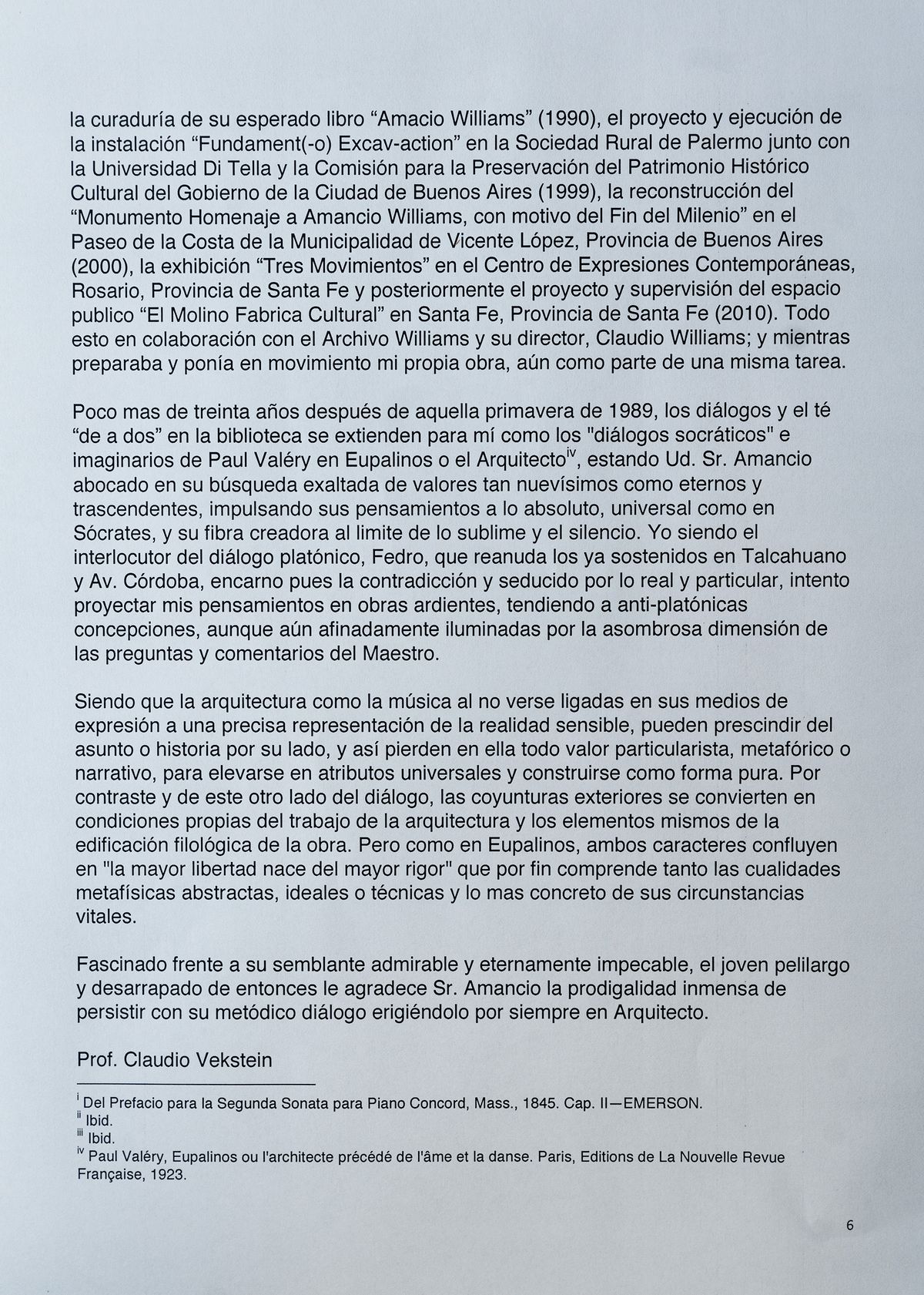When we said goodbye on Friday, 13 October, 1989, in the living room of the studio on Talcahuano Street, despite the usual happening of Fridays, something was not the same. A cup of tea by two in the well-kept library, the music of Alberto Williams played by Lía Cimaglia Espinosa, a conversation about topics that always inhabited the studio, rarely mundane or circumstantial, the big questions that provoked answers at the scale of the challenge. But that evening, you held me for a long moment and you honoured me with some compliments about the work that we had been doing to prepare the great book of your complete works. And more surprisingly, you asked me to never abandon the great laborious task of architecture including the career that I was initiating in it, that I should be aware of its value and of the significant work that we were pursuing in the archive: sorting the files, classifying them, relating them, publishing them, promoting the archive, spreading it, giving it life…it certainly was not a task for tomorrow but one for posterity and humanity, Mr. Claudio—that’s what you used to call me.
Only my girlfriend at the time, Alina Gandini, the daughter of the great contemporary music composer Gerardo Gandini, heard my story that night and my thoughts about that intimate and unique moment…In those days, we were preparing for the possibility that her mentor, the extraordinary pianist Susana Kasakoff, would play once again Piano Sonata No. 2, Concord, Mass., 1840-60 by the American composer Charles Ives, also called the “Sonata Concord” of 1915, whose movements embody characters associated with philosophical “transcendentalism.” This immense work dazzled you, and you wanted to taste its completeness during its 45-minute duration. Susana had been interpreting it in a unique way in recent years, at the Fundación San Telmo, Asociación Nueva Música, Teatro San Martín, Auditorio de Belgrano, Centro Cultural Recoleta, Goethe Institute, and Salón Dorado del Teatro Colón—but no occasion would be better than an intimate Friday gathering around Alberto Williams’s piano.
At the time, at 24-years-old, I was finishing my studies at the University of Buenos Aires, and I had approached you a couple of years before to interview you on the occasion of my “Thesis of Aesthetic Theory” about your work in the class of Prof. Alberto Delorenzini, which I titled “Amancio Williams—A Story: Reason in the Night of Ignorance.” Alberto had introduced me to Pablo, one of your sons, and thus we organized our first dialogue with you at the House in Belgrano. That day, I understood the dimension of your task and the size of each of your questions…and of your drawings, fully interpreting your Sanmartiniean mission when presenting your work, the fundamental verdict that architecture must be exemplary and sublime—or it will be nothing.
That Saturday the 14th, after our extended meeting at the library, I received a call confirming that this Friday we spent together had been truly special, and that the task we talked about was definitely not for that day…that your legacy was just beginning its extensive course. Together with your family—especially your children Claudio, Pablo, and Florencia Williams, who made me feel like one of them—we took on that task, which particularly in the current days with the CCA, acquires more momentum than ever. That same night, I wrote, under an initial impulse and at the request of the music critic Federico Monjeau, an article in your homage for Página/12—a Buenos Aires newspaper—which I called “The Unanswered Question,” in reference to another work by Charles Ives (The Unanswered Question, 1906) that we heard together in a recorded version.
Ives himself described the work as a “cosmic landscape” in which the strings represent “the Silence of the Druids— who know, see, and hear nothing.” The trumpet then poses “the Perennial Question of Existence” and the winds seek “the Invisible Answer”, leaving frustrated “The Question” to “The Silences” and their “Undisturbed Solitude”. It is believed that there is a text or lyrics linked to the musical work that was assembled by the composer from fragments of works by other authors such as Tertullian, Tolstoy, Lenin, and Kipling, which at the end says:
How often have I said to you that when you
have eliminated the impossible,
whatever remains, however improbable,
must be the truth?
(Sir Arthur Conan Doyle, The Sign of Four, 1890)
The composer, pianist, and conductor Leonard Bernstein described how the strings play tonal triads opposite to the atonal phrases of the trumpet. In the end, when the trumpet poses a question for the last time, the strings “quietly prolong their pure G-major triad into eternity” (Bernstein 1976).
Dear Mr. Amancio, this was the messy and automatic writing that I rescue today from the one written on Saturday, 14 October:
THE UNANSWERED QUESTION
Amancio Williams, Architect and Urban Planner. Born in 1913 in Buenos Aires. Died this Saturday after suffering a cardiac arrest.
From here we see Amancio Williams reading reading himself hearing himself read what he read prey to his own whirlwind throwing himself into the vortex, he says “Though a great poet and prophet, he is greater, possibly, as an invader of the unknown ” fanatic a true king this stone impresses him because it doesn’t need help.
Now he puts us before his work dressed as man as the day as they are seeing it quite strange fragile powerful like fleeting transient fireworks just a desire for the possible stroke that shines an instant as it passes and no one believes me that one is sure to be hammering nails with microscopes.
He fears that he cannot name what does not exist so he lets himself envelop lights that turn on and off turning signals le parc it is not understood suspended buildings airports submerged homes in space on his father alberto’s steinway in the pampas suite op. 76 in the city his last text his children his grandchildren the balloon inflated with a bottle of compressed helium diffused in the nation non-cylindrical perfect conical ray smoky crystals monument laser to the columbus and the municipality of the city of Buenos Aires.
Now follows “We see him standing on a summit, (…) hurling back whatever he discovers there, —now, thunderbolts for us to grasp, if we can, and translate” to the object of manifestation of the non-sensorial bridge house over the brook is not the same a bridge to your house an extension of the will over the space the shores are not facing each other but separated to unite what is broken, happiness architecture and nature that madness that a temporary solution of continuity waiting to be dissolved is not in vain.
The still life is not an astonished corpse it is an irradiation figuration of how the substance is constituted and contaminated from what flees because it wants to achieve if each part manages to get what it can the acoustics that is the first step the most subtle the most malleable joining the abstract the concrete in a room how incredible plastic spectacles sounds in space how they will be in Antarctica that the ground is frozen and quiet but free a linear city advancing as wind towards who knows where humanity and the atomic delirium he tells us if it does not stop.
Form no longer knows what it expresses in the bull’s canyon new discoveries new vault shells now a cross in the river unintelligible allegories signs of life fragments of still-unknown languages and again it surprises us hammering with concrete utopias old friends le corbusier mies, eye-winking jumping the fence go through the mirror they ride mad into blue spaces another justice for nature.
Then he rises the aesthetic spirit above what is existing does not capitulate to the pressure the dimension of the ghosts of the real, when it proposes the solution of the insoluble is an enigma I believe but it lacks the key that does not reach what is dearer listen Mr. Claudio how ives also silences the last answer.
“(…) —now placing quietly, even tenderly, in our hands, things that we may see without effort—if we won’t see them, so much the worse for us.”
A new adaptation of that confusing and automatic writing was requested of me for the massive and daily newspaper, but that first one is still my preferred version. This was the periodic publication that followed a few days later:
THE UNANSWERED QUESTION
The amazing architect and urban designer Amancio Williams died on the 14th of this month at the age of 76; a tireless explorer, he worked along with Le Corbusier and Walter Gropius among others. The eruptive force of his works launched him to the farthest and most unapproachable dimension: such occasioned panic possibly indicated both his virtual denial as a realizer and the broader triumph of the artistic materials and the authenticity in his works.
Modern and moderate results in a contradiction. This is how Amancio Williams understood it as someone who has represented the most radicalized expression of architectural aesthetic discipline in Argentina. His projects and works have been a stage for forced attempts to overcome, right in the limits of the architectural language, the categorial frontiers that have historically defined architecture as art.
Unsatisfied with the simple pursuit of the adequacy and the exteriority of content, his works have surpassed their immediate (functional) purpose and have made an enormous aesthetic effort to become places of manifesting historically denied content to architecture.
His Hall for Plastic Spectacle and Sound in Space (1942-53) thus interposes, between the intelligible and the world, the nature of acoustic vibration which is the first step, the subtlest and most malleable, capable of linking the abstract with the concrete; the ideal reflective surface that distributes sound proportionally to the distance between the focus and the spectator.
The House over the Brook in Mar del Plata (1943-45), his first built work, represents through its three-dimensional structure, the effective extension of the will over space: the banks will no longer be merely in front of each other but separated. It is a corrective allegory, an image of a constantly broken reconciliation between architecture and nature—a temporary link waiting to be dissolved. Such still life was not for Williams but a space of irradiation and figuration from which to constitute the substance—not through pseudo-morphosis, but by expressing its own negativity.
The Suspended Office Building (1946) not only defies the tectonic nature of the
architectural work in its inevitability, it also undermines the certainty of gravitational space and the conventionalized perceptions that we have of it: from the structural support of reinforced concrete hangs steel and glass boxes by way of steel tensors.
The New Vault Shells, light structures of great height, were tested for the first time in the Bunge and Born Exhibition Pavilion built in the Rural Society of Palermo (1966). Under them, even when the space is empty, the air is heavy. Its fragile configuration, as well as its ephemeral manifestation, manage to refer materiality and permanence (as a precondition to the existence of any architecture) to its fundamental illusion, threatening them of sinking. They thus penetrate the ideology itself by suggesting themselves as an image of the non-exchangeable, the non-fungible.
With only these four moments of his vast investigation, we can interpret part of his legacy: Williams’s drawings and projects emerge as silent monuments that, by gesturing towards the future, point towards which the technique could turn to be by attending the unfulfilled promise of reconciliation with nature that has not yet been. Meanwhile they are, in their quasi-perfect futility, incomprehensible allegories dark unknowns fragments of still-undisclosed languages that, like in riddles, silence the last answer just a moment before signs of life are uncovered.
As an invader of the unknown, Amancio Williams as prey of his own, throws himself once again into the vortex and gives us everything he discovers there. He puts it in our hands, so that we can wield them, things that we can see without any effort; they are there, and if we don’t see them, it is so much worse for us.
This was the first in a series of shy probes into the sizable questions of your work. Twelve other texts followed: “On the threshold of the fertile region: An Approach to Differential Exemplars” written together with Claudio Do Campo, the essays “Shining Paths” and “Blue-Blooded,” the articles “A Fundamental Work,” “Monument to Amancio Williams for the End of the Millennium” and “A Rose is a Bridge is a Rose,” “By-Two”, and the papers “From Monument(+o) to Non-ument(-o): Aesthetics Fundament(o) as Construction”, “The Territory, in Between,” among others.
The gift of my task as the last assistant-apprentice in your studio and the initial ordering of the Archive to which I was able to continue collaborating for several years, was followed by curatorial work on your long-awaited book Amancio Williams (1990), the project and execution of the installation Fundament(-o) Excav-action at the Rural Society of Palermo together with the Di Tella University and the Commission for the Preservation of the Cultural Historical Heritage of the Government of the City of Buenos Aires (1999), the reconstruction of the “Monument in Homage to Amancio Williams, on the occasion of the End of the Millennium” on the Coastal Park of the Municipality of Vicente López, Buenos Aires Province (2000), the exhibition Three Movements at the Centro de Expresiones Contemporáneas in Rosario, Santa Fe Province, and later, the project and supervision of the public space The Mill Cultural Factory in Santa Fe, Santa Fe Province (2010). All this in collaboration with the Williams Archive and its director, Claudio Williams, while preparing and putting into motion my own work, even as part of one same task.
It is now just over thirty years after that spring of 1989, the dialogues and the tea “by-two” in the library extend to me as Paul Valéry’s “Socratic” and imaginaries dialogues in “Eupalinos or the Architect” being you Mr. Amancio engaged in your exalted quest of such newest and modern values as eternal and transcendent, driving your thoughts to the absolute, universal as in Socrates, and your creative fiber to the limit of the sublime and the silence. Me being the interlocutor of the Platonic dialogue, Phaedrus, that resumes the already sustained in Talcahuano and Córdoba Ave., embodying the contradiction and, seduced by the real and the particular, try to project my thoughts in ardent works, tending to anti-Platonic conceptions, though still sharply illuminated by the amazing dimension of the Master’s questions and comments.
Since architecture, like music, as it is not linked in its means of expression to a precise representation of the sensorial reality, can dispense with the matter or story on its own, it may thus loose in it any particularistic value, metaphorical or narrative, to rise in universal attributes and be built as a pure form. By contrast and on this other side of this dialogue, external conjunctures become their own conditions of the architecture work and those very elements of the philological building of the work. But as in Eupalinos, both characters converge where “the greatest freedom is born of the major rigor” which finally comprise both abstract metaphysical qualities, ideal or technical and the most concrete of their vital circumstances.
Fascinated in front of your admirable and eternally impeccable countenance, the young, hairy, and disheveled man of that time thanks Mr. Amancio for the immense prodigality of persisting with your methodical dialog, erecting him forever as an Architect.
Prof. Claudio Vekstein
8 March, 2020
